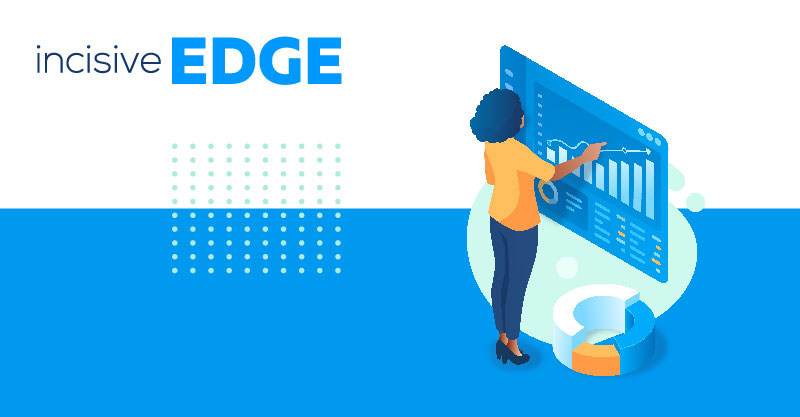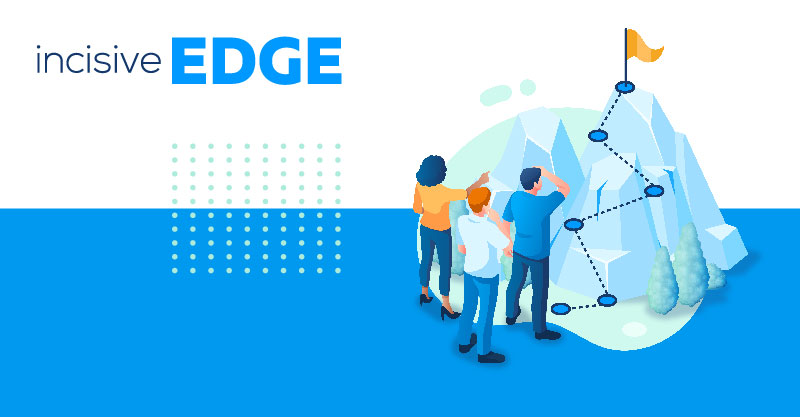First question – what’s a sales funnel?
Here’s a good looking one, courtesy of Endo Creative:
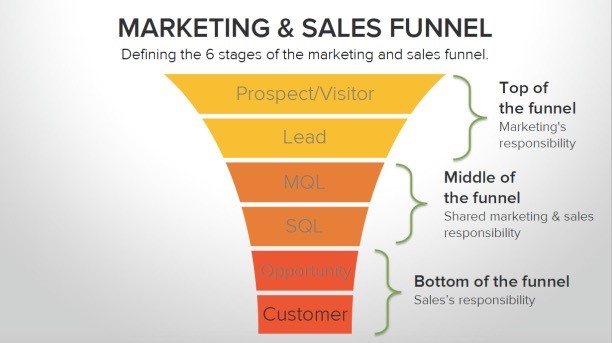
Your sales funnel – or your marketing and sales funnel, to give it a fuller title – is simply a visualisation of the marketing and sales process.
Second question – what’s the marketing and sales process?
Illustrated in the image above, the marketing and sales process unfolds as a multi-stage endeavour. In this strategic approach, inbound marketing and sales teams guide potential customers through distinct sales funnel stages. These stages represent key phases in the customer journey, each designed to nurture and lead prospects towards making a purchase. To better understand this intricate process, let's embark on a brief walkthrough, exploring the dynamics of sales funnels and the customer journey to achieve effective conversion and sales outcomes.
Check out the following articles to learn more about Sales funnels:
- ABM Lead Generation: How to Reel in High-Value Prospects
- 3 Great Design Tips to Increase Website Conversion Rate
- Your Fintech Marketing Strategy: The Best 2023 Guide
The Sales Funnel in Three Steps
The marketing and sales funnel can essentially be broken down into just three stages:
- Step 1 – Attract strangers to visit your website (top of the sales funnel – ToFu)
- Step 2 – Convert visitors into leads (middle of the sales funnel – MoFu)
- Step 3 – Convert leads into customers (bottom of the sales funnel – BoFu)
Simple enough, right?
Right – but, there are a couple of more questions that need to be answered.
Third question – what’s a lead?
Good question – and one that many companies get a little bit stuck on.
Leads are not random visitors to your website (as it is sometimes assumed). Rather, leads are special visitors in the fact that they make some sort of indication that they are more deeply engaged with your website’s content and are considering a purchase.
This indication is given when a visitor takes a specific action, which is usually in the form of submitting some personal information (for example an email address) in order to access gated content.
Which leads us nicely onto the next question…
Fourth question – what’s gated content?
Gated content is the content that you only give access to in exchange for information from the recipient – i.e. a name, email address, business name, profession, etc.
By gating content, inbound marketers are able to separate regular visitors from special visitors, and identify personally who their leads are.
Not All Leads Are Created Equal
Indeed, they are not, and this is because not all content is created equal either. Within the marketing and sales funnel image above, one encounters various stages: the sales funnel process, where leads, MQLs (marketing qualified leads), SQLs (sales qualified leads), and opportunities unfold. The critical task for an inbound marketing and sales team involves determining the lead's nature based on the specific content they seek access to, such as sales funnel examples. This nuanced understanding is indispensable for identifying a potential customer and strategically guiding them through the intricacies of the sales funnel process.
So let’s break our visitors and leads down:
Visitors – Simply enough, strangers that visit your website.
Leads – A visitor that has submitted information in exchange for “basic” content – i.e. they have subscribed to your blog or email newsletter.
MQLs (marketing qualified leads) – These are your visitors that have downloaded pieces of content not freely accessible on your website. The type of content in question is usually an eBook or whitepaper that explains in greater detail a little more about the business or solution. To give an example, telecoms company LG Networks gates an eBook entitled ‘Top Ten Tips When Considering VoIP’, asking downloaders for their name, email address and business name in exchange for the content.
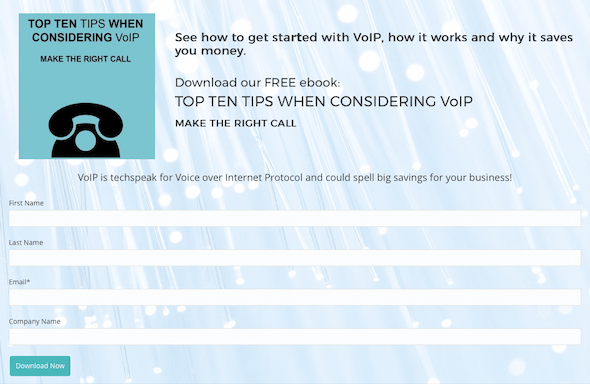
SQLs – Indeed, they are not just any MQLs; these are special MQLs identified by the sales team as deserving a follow-up. This distinction often arises when delving into the details of the company that downloaded the MQL-identifying content, revealing it as an ideal fit for a sale. In different scenarios, an SQL might be recognised based on the nature of the downloaded content. Notably, the request for price lists is a reliable indicator that the lead is actively considering a purchase, making them eligible for a strategic sales call. This astute identification process is instrumental in shaping a successful sales funnel tailored to the specific needs and behaviours of the target audience.
Opportunities – These are special SQLs in the fact that the sales team has successfully made contact with them, and can confirm that they are indeed a true potential new customer.
Customers – These guys need no explanation.
How to Use Content to Move Leads Through Your Sales Funnel
Ok, so we now understand the differences between visitors and leads, and the differences between MQLs, SQLs and opportunities. Next, we need to understand the inbound marketing content strategy that is used to move these leads through the sales funnel and convert visitors into customers.
Here it is.
Top of the Sales Funnel (ToFu)
This is the attraction phase, and so we need to create lots of free content that will interest our potential customers and give them simple means to visit our website.
All content marketing begins with – though is by no means limited to – a blog. Your blog is your chance to attract visitors to your website through providing interesting, industry-relevant, well-researched articles that are appealing to a certain type of internet user (as defined by your inbound marketing personas).
A regular blog gives strangers a reason to visit your website. You will use it to position your business as an industry authority, shed light upon some of the difficulties your target customers may be facing (and help them solve these difficulties), and talk about what you’re up to in the world that your business resides in.
Importantly, you will promote your blog on social media, and thusly drive users of these networks towards your website. And you won’t stop at blogs. Videos, infographics, SlideShares, surveys, competitions – all of these and more can and should be used to drive people to your website as well.
A well-executed ToFu strategy will result in many visitors. However, as we’ve already established, what we now need to do is generate leads from this traffic.
MoFu (Middle of the Funnel)
At the heart of the sales funnel lies the crucial task of capturing visitor information. Having sparked interest through well-crafted blog (or other) content, the next strategic step involves presenting high-value offerings to your visitors. Importantly, this requires a subtle request for them to surrender some details in exchange for this valuable content. This strategic manoeuvre is not just about tactics; it's an integral part of the sales funnel strategy. It seamlessly guides prospects through the intricate stages of the sales cycle, ensuring a methodical progression that transforms them into valuable prospective customers.
You can see that in today’s world of instant gratification, gating content in this manner means that only those that are serious will go through the effort (albeit minimal) of completing this task.
Nonetheless, this gated content must be suitably attractive, and the value that’s offered (usually communicated by the title and perhaps a short synopsis) sufficient to entice people enough to make that effort.
eBooks, case studies, research reports and white papers are the types of content in question. And, importantly, this content will be valuable to downloaders in the sense that it will give them additional information on how they can grow their business by employing a solution like yours. Here at Incisive Edge, we practice what we preach, as can be seen from our Resources Page:
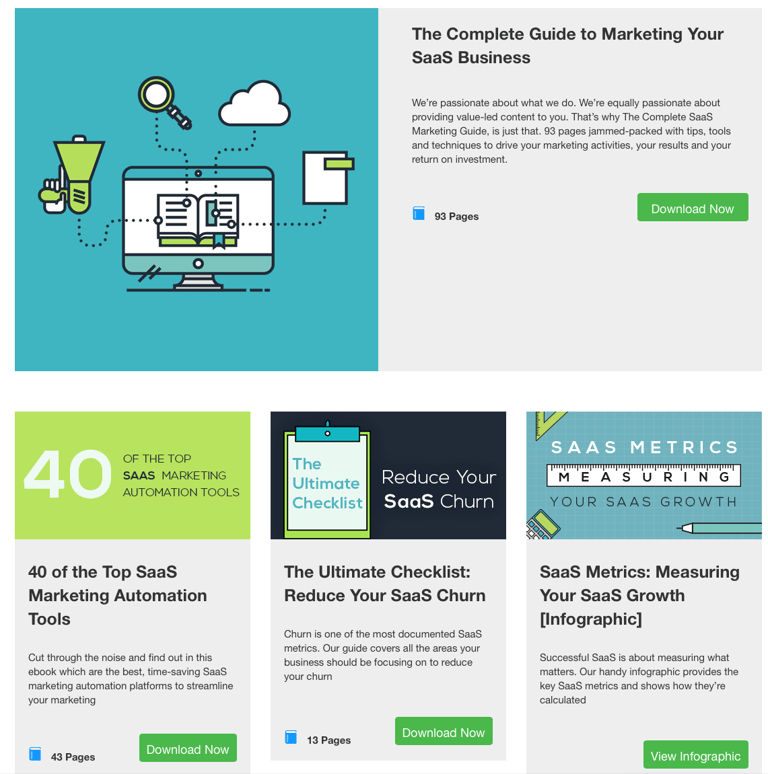
We know that content marketing works because it works for us. Many people download our gated content every single day, and from the information we capture, we are able to identify MQLs and SQLs accordingly – and can then move onto the next phase.
BoFu (Bottom of the Funnel)
So, we’ve captured some email addresses – what next?
Well, naturally enough, emails.
When a lead is generated and identified, we need to reach out to them – with more content. If they’ve downloaded a “complete guide”, then perhaps they’d be interested in a case study that provides a real-world example of the tangible benefits that our solution already provides for a happy customer. Rather than leaving it to chance that this lead returns to our site and sources this case study themselves, it makes sense to do the work for them and send it across directly in an email.
The email itself forms the content in question, and will be designed to generate a direct response from the prospect. Something like this:
Hi Jo,
Hope you enjoyed our “Complete Guide” – thanks so much for downloading.
I’ve taken a look at your business’s website and think that we’ve got the perfect solution to help you grow. I’ve attached a Case Study that shows how we helped a similar business to yours – check it out.
If you’d like a chat any time, then please just reply to this message and let me know a good time to call.
Looking forward to hearing from you.
Take care, Jo!
[Signature and contact information]
A positive response to such an email will indicate that the prospect qualifies as an opportunity, and, through a few more email exchanges and most likely a phone call or two, the sales team can close the deal and win a new customer for the business.
To Summarise
So, let’s walk through the process of using content to move leads through your marketing and sales funnel one more time in the simplest of terms.
Step 1 – Use blogs (and other content) to attract visitors to your site
Step 2 – Employ gated content (eBooks, white papers and case studies) to capture lead information
Step 3 – Use email marketing to seal the deal
That’s the essence of using inbound marketing to lubricate the sales funnel right there. Now all you have to do is adapt your content strategy at each phase in a way that’s most suitable for your business.









